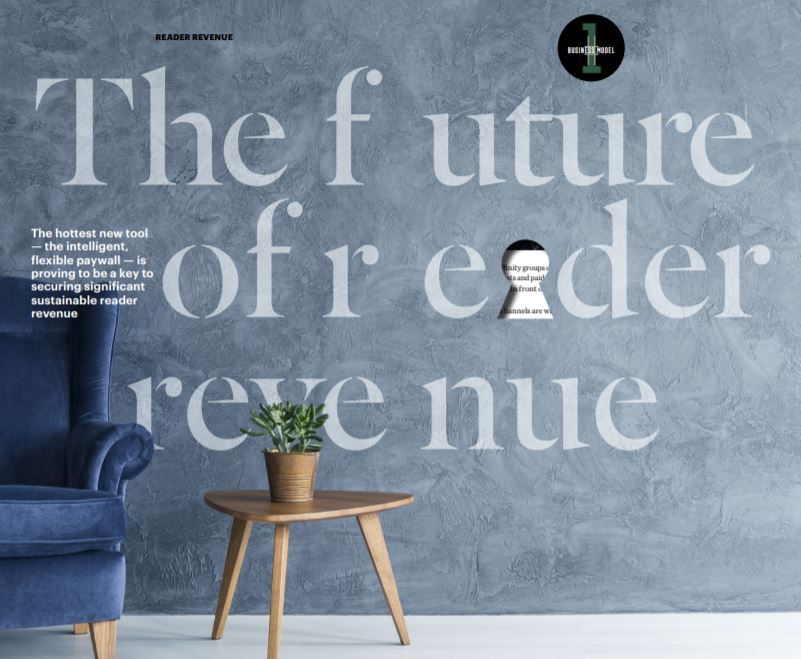
16 Sep READER REVENUE: SUCCESS STORIES FROM THE FRONT
In the early days of the internet, the prevailing wisdom was that content had to be free. Not anymore… and it was never very wise in the first place! In the last few years, more and more media companies are charging for and consumers are paying for content that used to be free.
“Why are users buying it now?” asked media critic Peter Houston writing in Publishing Executive. “The biggest driver is quality — or the general lack of it. “There is just so much bad content out there that it is finally worth paying to cut the crap,” he wrote. “In a time of global political turmoil reported against a backdrop of ‘Fake News,’ people want information they can trust, some enough to pay for it,” Houston wrote.
Also, he wrote, publishers are finally becoming more confident about restricting free access as they watch digital advertising shrink and witness other media companies finding success with paywalls. But those aren’t the only drivers motivating readers to pull out their credit cards.
The New York Times is playing to its audience’s “constant thirst for self-improvement,” according to Times Reader Experience Product Director Sara Bremen Rabstenek speaking to journalism think tank Nieman Lab. “This is all about how we can provide subscribers with the type of content that makes them feel like they’re getting insight they’re not getting anywhere else,” Rabstenek said Schibsted-owned Svenska Dagbladet has found that need-to-know material converts free readers to paying readers.
Executives there say that content related to how to live your life and understand the world moves people to pay while nice-to-know content (guides, arts, reviews) is a key for retention. It’s also all about taking advantage of reader habits to become a habit ourselves.
“We know people pay for habits. So we want to focus on habits. Habits are the best way to increase engagement,” Financial Times Head of Product Gadi Lahav told WAN-IFRA. More and more publishers are moving aggressively to grow subscription revenue as digital ad revenue continues to shrink and as the old reasons to provide content for free — scale and clicks to satisfy advertisers — have been proven to be empty measures of success.
The lesson of the past five years has been not to undervalue ourselves.
-Pam McCarthy, New Yorker Deputy Editor
The vast majority of people (or bots) behind those clicks never came back, never clicked on ads, and never subscribed. The early success stories in the move to entice readers to pay have been encouraging and, in some cases, eye-popping. For example, The New Yorker is one of an increasing number of media companies where reader revenue now exceeds advertising revenue, 65% to 35%. Paid circulation hit 1.2 million in 2017, an increase of 12.3%, despite a subscription price hike the year before of 20% to US$120 for print and digital. Based on that performance, New Yorker executives have said they expect to double the number of paying subscribers by 2023.
“It was scary to think about charging three-figure sums,” New Yorker Deputy Editor Pam McCarthy told Digiday, recalling the decision to raise the price of the bundle to $100 in 2016. “Then, we thought, people in their 20s are paying for Netflix when we were embarking on this increase. And The [New York] Times’ success is encouraging, as well as The Washington Post’s growth. The lesson of the past five years has been not to undervalue ourselves.”
In early 2018, The New York Times announced a 26% increase in new digital-only subscribers (up 139,000). Of those new subscribers, 40,000 came from new subscription-only apps (Cooking and Crossword). By the third quarter of 2018, The Times had grown to 2.9 million digital-only subscribers. Combined with print subscription revenue, The Times said the revenue from their 3.8 million total subscribers now accounts for nearly two-thirds of its total revenue.
Subscriber acquisition strategies vary
Like many other media companies succeeding with reader revenue, The New Yorker has used multiple strategies to achieve its goals: Newsletters (nine of them!), niche topic coverage (politics, business, food), personalised subscription pitches, and targeting affinity groups on Facebook and Google with paid posts and paid search keywords to get their content in front of potentially new audiences.
“Those digital channels are what’s opened up The New Yorker — that’s changed the way we reach consumers,” Condé Nast EVP/Consumer Marketing Monica Ray told Digiday. The growth in subscribers has also driven new advertising revenue. “The growth in paid circulation has become a huge selling point with advertisers,” said Condé Nast Chief Business Officer Chris Mitchell speaking to Digiday. “Circulation was always the most boring slide in your deck, and now it’s the thing you lead with,” he said. “It’s nice to have a more balanced business because advertising can be a more cyclical and fickle thing.”
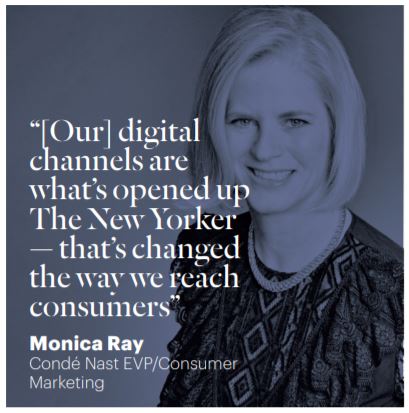
The hottest reader revenue strategy:
Intelligent, flexible paywalls It’s amazing (mind-boggling, actually) to think that in an era of increasing personalisation we ever thought that a one-size-fits-all paywall would work. But the industry was too focused on the radical, audacious act of actually charging for content itself and there were no proven models to mimic.
Plus, it took time to figure out the algorithms and artificial intelligence tools to make smart, flexible paywall work. But today, several media companies have successfully demonstrated that intelligent, flexible paywalls work very well indeed. The systems are driven by reader behaviour and designed to maximise the uniqueness of a reader’s experience. Using artificial intelligence, the algorithms gradually come to understand a reader’s behaviour and can thus eventually deliver a personalised subscription pitch.
The problem with the one-size-fits-all paywall models is that they assume that every buyer has the same “tipping point”, the same threshold, Wall Street Journal Analytics Manager John Wiley told The Drum. Some media companies are still launching one-size-fi ts-all metered paywalls (Vanity Fair, Wired, the New Yorker, Bloomberg). And some still work well. The Wired paywall (four free clicks a month), for example, has helped increase print and digital subscriptions more than (get this…) nearly 300% in its first year!
The Wall Street Journal’s flexible paywall has 60 variables and adapts to behaviour
To meet its four-year goal of hitting 3 million global subscribers, The Wall Street Journal spent four years building a paywall based on a machine learning algorithm that measures reader activity across 60 variables and then adapts the wall to each reader’s behaviour, delivering a free-story limit only in the areas of their interests.
The variables include frequency, recency, depth of read, favoured devices, and preferred content types. The result is a “propensity score” to predict each reader’s subscription probability which then determines how many free sample stories a reader can access.
“We are a dynamic paywall, we can flex based on audience but as far as the consumer sees, we are a freemium paywall,” Wall Street Journal General Manager of Membership and Subscriptions Karl Wells told The Drum. “The principle is to sample content to people whom we know need it. By doing so, their likelihood of subscribing will rise.”
Like other publications, the Journal had been relying on editors to make the content paywall decisions. “The decision of whether a piece of content was locked or open was made by the newsroom,” Wells said.
“They were good, they had great gut instincts around what people would or wouldn’t pay for, but with our [algorithm], they can concentrate on what they do best, which is creating journalism that is worth paying for, and we can monetise interest and intent,” he said.
An adaptive paywall gives subscription marketing teams unique powers. “It allows you to pick the threshold based on past patterns of engagement. If there is a certain type of reader who will most likely convert on their fourth visit and another type who most likely converts on the seventh, the model will reflect that,” Journal Analytics Manager Wiley told The Drum. “You are looking at the full history of people who have subscribed to us.”
…With our [algorithm], [journalists] can concentrate on what they do best, which is creating journalism that is worth paying for, and we can monetise interest and intent.
-Karl Wells, Wall Street Journal General Manager of Membership and Subscriptions
The Journal found that non-subscribed visitors fall into groups that can be roughly defined as hot, warm, or cold, Wells told the journalism think tank Nieman Lab. Those with high propensity scores — indicating a high likelihood of subscribing — will hit a hard paywall early.
The warm and cold visitors get to access stories for free for a while — but then they hit the paywall. Depending on their propensity score, readers might also be offered guest passes to the site, in various time increments, in exchange for an email address (thus giving the Journal more signals to analyse), Wells said. The passes are given to people whose scores indicate they could be nudged into subscribing if tantalised with just a little bit more Journal content.
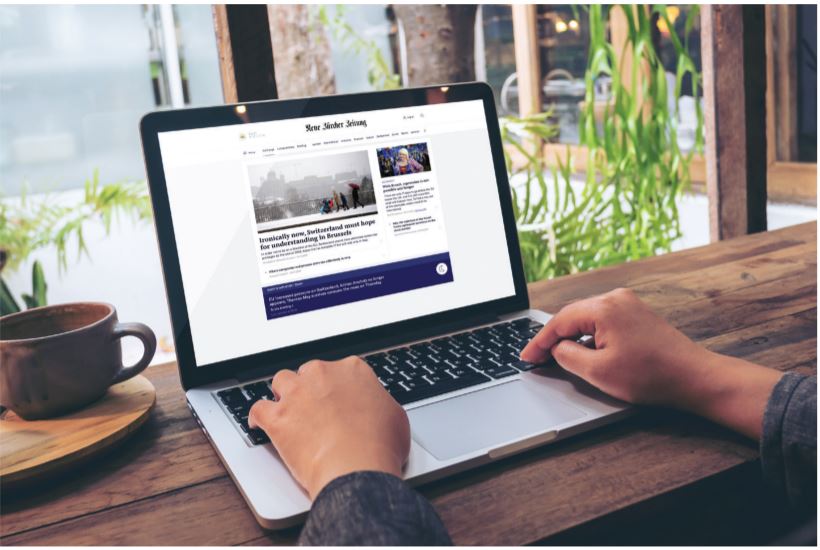
NZZ’s personalised payment system
Scandinavian media house Schibsted also has a prediction model that can identify visitors who are three to five times more likely to subscribe, and it pitches different offers to them than they pitch to other visitors.
Another European news publisher, the 200-year-old Neue Zürcher Zeitung (NZZ) in Switzerland, also created a personalised paywall. The success of the NZZ paywall has contributed to the doubling of reader revenue as a per cent of total revenue (from 30 to 60%) in ten years.
“If we’re to be successful in paid content, we need to individualise the experience with our product and the product itself, and automate our marketing approach,” NZZ Managing Director Steven Neubauer told Digiday. “Based on that hypothesis, this approach will increase engagement, retention and conversion rate.”
Neubauer has been proven correct as NZZ has increased its conversion rate fivefold in the last three years(!), with 2.5% of people who view a payment message subscribing. The NZZ site has nearly 600,000 registered users, an increase of more than 40% in 2017, and is adding between 10,000 and 12,000 per month, Neubauer said.
The NZZ system uses 100 to 150 data points, including reading history, time spent on articles, frequency, the number of newsletters they receive, their device, and the time of day they visit, Neubauer said. Based on that data, NZZ is able to tailor the messaging, text, placement, timing, and colour of the pay prompt readers see.
For instance, Neubauer said, between 5am and 9am when people are commuting, they’re reading on their smartphones and won’t want to put in payment details, so no payment messages are shown during this time and people can freely access the site.
When readers reach the top 20% of the propensity score, they are served the payment prompt that matches their interests. NZZ links article metadata with user journeys, so someone who has read a high number of articles on banks in Zurich, for instance, will receive a payment message on the next relevant article they read. And adding personalised greetings to landing pages increased conversion by 25%, Neubauer said.
NZZ has also found that heavy users who have registered but not yet subscribed tend to convert at a higher rate when they see an offer for an annual rather than a monthly subscription, according to Neubauer. Even smaller publishers who don’t have access to the staff and engineering assets of The Journal can create flexible paywalls, the Journal’s Karl Wells said.
“It has taken a group of talented people to create this solution but there is a sliding scale of complexity,” he said. “The biggest opportunity for publishers is to recognise that intent levels differ by user — if you recognise that and reflect the experience based on that, then you can get to a better place.
“It does not have to be a machine-operated algorithm,” he said. “Publishers understand recency, frequency and depth. You can use those three measures to judge intent. If I am a metered model, why not create a hybrid meter? Someone who is completely new and hasn’t used anything, should I be giving them more than someone I can measure a degree of intent against?”
The biggest opportunity for publishers is to recognise that intent levels differ by user
-Karl Wells, The Wall Street Journal
In March of 2018, Hearst Newspapers replaced its simple paywall where editors chose the content to be paywalled for all readers. Now, it’s the readers themselves, by their reading preferences and history, who ultimately determine what content goes behind their own paywall. First-time readers can access as much content as they want.
As the Hearst system detects a reader’s interests, those types of stories eventually end up behind the paywall and those specific interests are the focus of the subscription offer they receive. For example, a sports fan would get an offer focused on getting the inside stories of the teams they follow, an arts lover would get an offer around their cultural interests, food lovers would get a pitch about recipes or restaurants, etc.
At Hearst’s Albany (New York) Times-Union, the first newspaper to test the flexible paywall, the total number of digital subscribers has doubled since it started tests in September 2018, and the overall number of new subscribers for Hearst Newspapers has jumped 10%, according to Hearst Newspapers President of Digital Media Rob Barrett speaking to Digiday.
New content drives new revenue and better retention
The type of content you’ve been producing for years may be appealing enough to entice users to pay. But new content built around niches your data show are reader magnets most definitely will get readers to pull out their credit cards.
Some publishers sell the new content as standalone products while others use the new content as enticements to subscribe.
For example, to entice new subscribers to its Golf Digest, Condé Nast launched Golf Digest All Access, a service offering more than 200 instructional videos, live and interactive coaching clinics, plus a print subscription to Golf Digest, for $9.99 per month or $100 per year. The videos were also sold individually for US$10 initially with the price set to rise to US$24.99.
The driving factor in the decision to launch All Access was that data showed instructional content attracted the most engaged readers, Golf Digest Digital GM Chris Reynolds told Digiday. Seventy per cent of the site’s audience reads at least some instructional content, but the most engaged audience members would look at it four to five times every month, he said.

Why did Golf Digest price the All Access subscription below the price of the individual video? Reynolds said they wanted to encourage people to subscribe, which drives recurring revenue, versus the one-time revenue from a video sale. The low price point was meant to make it easy for people to subscribe, and for Golf Digest to later add on and charge for other services, such as exclusive photos or tee times, he said.
“We are really keen on making a subscription seem more and more valuable to readers, both to people who are already subscribing, and people who are not subscribers who we want to give more reasons to subscribe,” Ben Cotton, the Times’ Executive Director of Customer Experience and Retention told the journalism think tank Neiman Lab. Some of the products are built using archives of existing content (Cooking and Crossword) and others are brand new creations (Parenting).
To determine if a category will drive people to pay for it, The Times looks at different measurements: the market opportunity, the potential to build a subscription business, un-met needs in the market, and whether the Times has an advantage in meeting that need. The New Products and Ventures team then conducts focus groups and one-on-one interviews to elicit the consumer needs that will drive a prototype for testing.
New content built around niches your data show are reader magnets will get readers to pull out their credit cards.
In 2018, the New York Times declared it the “Year of Living Better,” and created a new series of guides for improving aspects of readers’ lives, producing one new guide every month. Rather than have the guides be part of the metered paywall, the ONLY way a reader could access a guide was to be a subscriber.
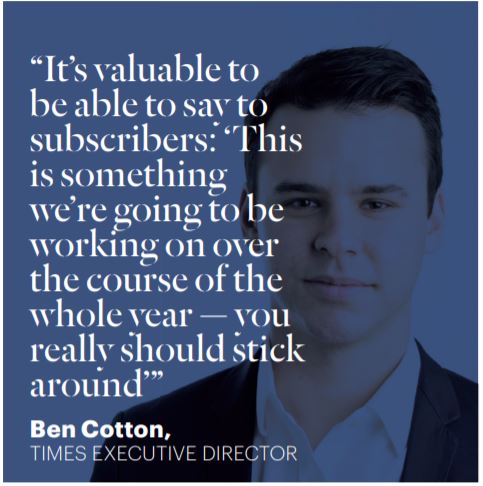
“It’s valuable to be able to say to subscribers: ‘This is something we’re going to be working on over the course of the whole year — you really should stick around,’” Cotton said. “We’ve also had a lot of success in the last year-plus from our Crosswords product and our Cooking product [US$4.8m in combined revenue in the first quarter of 2018], which are now also subscription products that you can pay for on their own or as part of a bundle,” Cotton told WAN-IFRA.
“We’ve seen a lot of success using those in every way: We’ve gotten people who don’t want to subscribe to the Times otherwise but do use one of those products to become a Times’ customer, and we’ve gotten a lot of people to subscribe for more money by bundling all those things together in one package or special offer. We’ve also seen success in trying to get current subscribers to use those products in a way we think can drive retention.”
Politico Europe is also building more vertical-specific products and services that meet the needs of its European audience and distinguishes them from their competition. For example, the new Pro subscription (starting at US$8,700/ year) includes a unique research and presentation tool called DataPoint.
The company hired three data analysts to do complex market analyses that are then converted into charts and graphs which are embedded in white-labelled presentations subscribers can download and use in their jobs. In mid-2018, Politico Europe had created 30 presentations and was producing new presentations at a pace of three every week. Politico’s overall revenue grew 30% in 2017 over 2016, according to the company, and they say they will reach break even in 2019 (they launched in 2015).
Old rules of retention are new again
Since the birth of the internet, with the focus on free content, retention of existing subscribers took a back seat to driving ever more clicks from wherever they could be found. Now that reader revenue is becoming the dominant source of revenue for more and more media companies, we are seeing a return to the obsession with retaining those paying readers.
“If you want to grow your subscription base, you have two options: growth is coming from acquisition or from retention,” Financial Times Head of Product told WAN-IFRA. “But our data, and data from all over the world, show that it is four to five times cheaper to retain an existing user than to acquire a new one. And while we invest quite a lot right now in acquisition, we invest much more in retention and engagement, and how we do that is we use basically data.”
“We’ve been very conversion-driven, but the focus is moving towards usage, getting customers to stay on our sites,” Schibsted Media SVP Consumer Business Tor Jacobsen told WAN-IFRA. “We have perhaps over-focused on sales, for most of our brands, and sales are often deal-driven, which produces high churn. The goals going forward will be more about lifetime value of users, for both our subscription and non-subscription news brands.”
At the Washington Post, the focus is also on retention, with special features and content for subscribers only. One Post strategy is to offer paying readers a better experience with a new article format called News Reader. The article page is cleaner, offers infinite scroll, indicates where the reader is in the story, and, in some cases, contains fewer ads.
Another is a first for the Post: subscriber-only content, including a subscriber-only newsletter. Another subscriber-only content offering is an audio series called “American Stories” that will be emailed to subscribers and also be available on the website but behind the paywall.
Tellingly, back in late 2016, the Post had no one dedicated to working on retention. Today, there are 25 people who work on retention in some fashion, of whom 15 are totally dedicated to it. Similarly, The New York Times tripled its retention-focused staff between 2015 and 2017.
At Scandinavian publisher Shibsted, anti-churn activities have also moved from the back bench to the front line. “Work with digital churn is more important than ever,” Schibsted Chief Commercial Officer Tor Jacobsen told Digiday. “We are going from a very sales- and volume-driven phase where we have had a tremendous growth in new subscribers to a phase more about keeping the subscribers and making them happy. You need to do a lot of different activities; we are approaching the different customer steps in a much more targeted way: on-boarding, anti-churn work with existing customers, loyalty programmes, win back. These steps all need different actions.”
Newsletters as subscription and retention drivers
At The Times of London and Sunday Times, newsletters play a key role in exposing potential subscribers to content that appeals to them in the hopes that they’ll hit their weekly limit and convert to subscribers.
The Times delivers its daily Best of Times newsletter (with the top news, business, sports and opinion stories) to readers who register with their email addresses. Four other newsletters built on football, automotive, style, and food are also available to non-paying but registered users.
The Times created another 20 newsletters for paying subscribers that include content not available on the website. According to The Times, newsletter subscribers are the most engaged readers, especially the paid subscribers who are far less likely than subscribers who do not receive newsletters to let their subscriptions lapse.
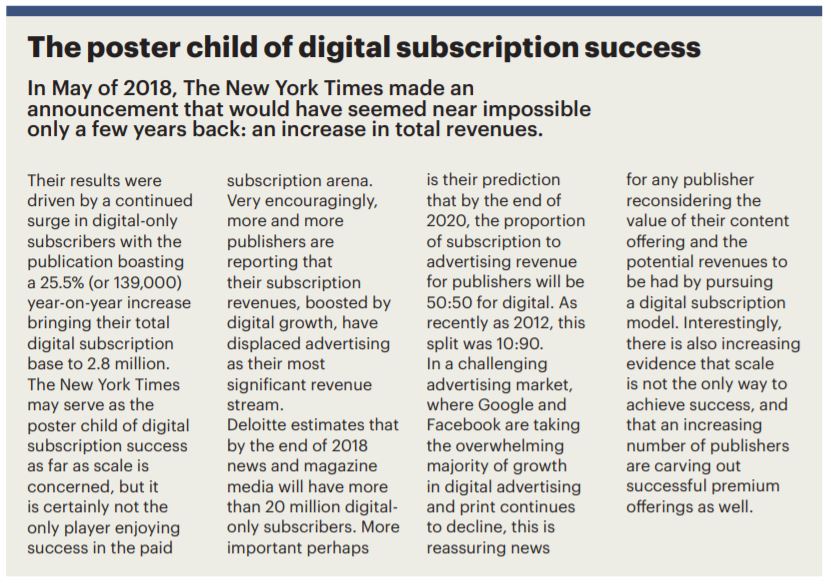
Micropayments are working for some
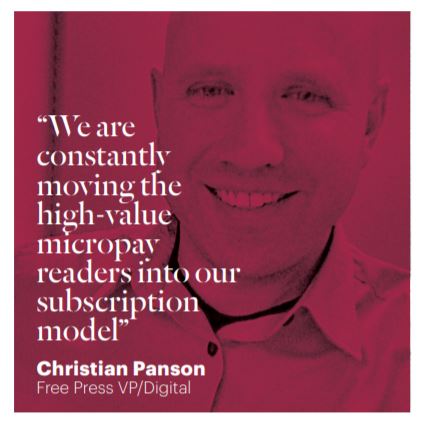
In addition to micropayment pioneer Blendle in the Netherlands, Germany and the United States, the Winnipeg Free Press in Canada is the only legacy media company to have fully embraced micropayments.
After launching their paywall in mid-2017, the Free Press one year later is selling 892,000 articles per month at US$0.27 per article. While that isn’t game-changing revenue, it does represent another runway to bring in subscribers while making money in the process.
“We are constantly moving the high-value micropay readers into our subscription model,” Free Press VP/Digital Christian Panson said during a 2018 INMA webinar.
The micropayment system eases readers into the idea of paying for content by just asking them to pay a small fee for one article at the time that they want it. “Micropayment allows people to get into the habit of paying for news, and reinforces the value of the content because we’re saying that every piece of content has value,” said Panson.
“The biggest benefit we’ve really seen from micropay is that it lowers the commitment,” Panson said. “What we created was this pattern of behaviour — it was a pretty high wall to cross when the reader just wanted that one next story. Commitment is a big barrier, too; it’s not just the money. That notion that I’m going to be tied to something, I’m going to have to cancel later.”
A side effect of this system is that it allowed the Free Press to lower the number of articles a reader is able to access for free. This has improved both activation and churn rate.
Subscription boxes can be lucrative
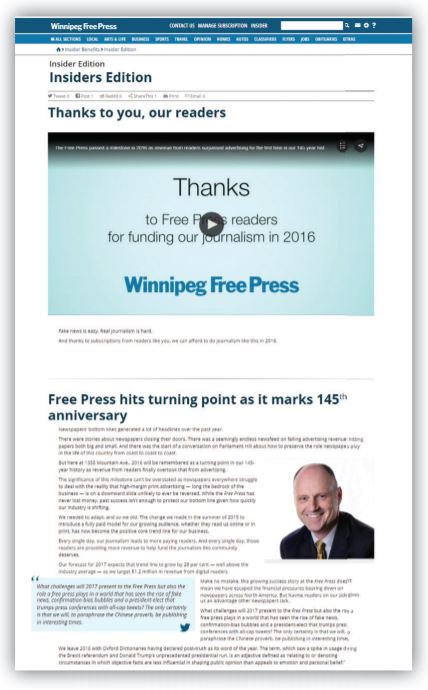
In just two years, Mike Velez, the publisher of Brazilian Jiu-Jitsu Magazine, has grown its subscription box revenue to where it accounts for more revenue and profit than the magazine operations. But it is his position as a respected niche magazine publisher that enabled the success. “I couldn’t have done this without the unique position having the magazine affords me,” said Velez. “A successful subscription box is curated by those who really know their customers’ tastes and preferences,” wrote Velez in Publishing Executive. “That’s what makes magazine editors great curators for a subscription box. Magazines like Runner’s World, Men’s Health, and Cosmopolitan have all launched successful subscription box businesses to service their readers along with new customers. We advertise that our subscription box, The BJJ Box, is curated by the editors.
“Figuring out the product mix will take a little intuition and research,” Velez wrote. “Figure out what your readers would want on a recurring basis. Small group surveys through email can help give you a sense of what to include. When looking for products, the first contact should be with companies you already do business with, advertisers or prospective advertisers.
“Having a subscription box has helped me sell quite a few ads,” wrote Velez. “Writing a check to an advertiser that’s providing you great value strengthens the fact that we’re partners. It also makes closing the sale on a prospect that much easier when immediate revenue can be tied to that new ad contract.
Having a subscription box has helped me sell quite a few ads.
Mike Velez, Publisher, Brazilian Jiu-Jitsu Magazine
“The obvious target for your box offering is your existing readership, both subscribers and those that pick it up on the newsstand,” wrote Velez. “They should be solicited in your social media, through email, within the magazine, even through texts. Your good reputation will translate into sales with minimal marketing expense. Influencers in your space are also a valuable tool. I recently started instituting an email drip sequence for new magazine subscribers that offers them a bonus item in their first BJJ Box. So far, it’s proven very successful with a nearly 18% conversion rate.
“When I first took over the two subscription boxes businesses, each company had one offering: US$25 plus US$9 shipping,” Velez wrote. “I immediately added a US$35 VIP plus shipping option. Since then, I’ve increased the pricing to US$27.99 and US$37.99 plus shipping. Sixty-eight percent of those that sign up for the lower option upgrade to the VIP offer within the first 60 days. In total, the VIP option outsells the basic by a ratio of 3:1.”


